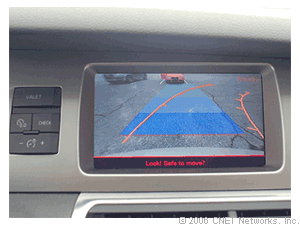
by Carey Russ
Aren't SUVs supposed to be dead? With the introduction of the 2007 Audi Q7, the company's first SUV, Audi is betting that they're not. Even if SUV sales have flattened out, they still represent a significant portion of the American automotive market, and the Q7 was designed with American sales first in mind. As Audi CEO Johan de Nysschen said during the recent Q7 press launch in San Diego, California, it is "the most important new model launch in the history of Audi in North America."
Audi considers the Q7 to be a third-generation performance-luxury SUV, with truck-based models making up the first generation and car-based crossovers the second. Contrary to expectations, it is not merely a stretched version of the Volkswagen Touareg. Parts commonality is 15 percent, mostly in suspension pieces. The Q7 is longer and considerably more spacious inside, with standard seating for seven in three rows. Power for all initial examples comes from the latest version of Audi's 4.2-liter V-8, with a model featuring a new 3.6-liter V-6 to debut later in the year. They will also use the latest version of Audi's Quattro all-wheel-drive system.
The Q7's unibody structure is made from high- and ultra-high-strength steel, with aluminum panels for its fenders, hood, and tailgate. An optional air suspension with adjustable ride height improves both on-road comfort and off-road clearance and ability. The ESP electronic stabilization system has an off-road mode that allows more slip at low speeds, common on loose surfaces such as dirt or snow.
Audi Side Assist uses intelligent radar technology to monitor the Q7's rear-quarter blind spots and alerts the driver by lighting LEDs in the appropriate outside rearview mirror if a potentially unseen vehicle is detected. The rearview camera and parking system overlay the rearview image with colored lines that show the Q7's path, allowing the driver to detect potential obstacles. It also shows the rear bumper and tow hitch so that it's easier to attach a trailer.
A new radar-based adaptive cruise-control system is available. It operates at speeds from 0 to 90mph and automatically brings the Q7 to a near stop in traffic. Integrated with the main vehicle network, it communicates with the engine, transmission, and braking computers.
A DVD and GPS navigation system and Sirius satellite radio are also on the options list. Later in the model year, Audi will offer a rear-seat DVD entertainment system that features removable DVD player units that dock to the front headrests.
Pricing is $49,900 for the base Audi Q7 and $59,900 for the Premium model; the latter comes with an upgraded interior and features that are optional on the base model.
Upside: The Q7's interior ambience and vehicle dynamics are pure Audi; you won't find a truck anywhere in its genealogy. All examples at the press launch were equipped with air suspension, the panorama sunroof, Side Assist, and the rearview system.
Its interior design is based on the Audi A6's, with first-rate seat comfort for the front two rows and more space than expected for the third. Access is relatively painless. The panorama roof is positioned to give all occupants--even those in front--a great view of the sky.
As in other Audis, the MMI control system is the interface to nearly every vehicle function. Its LCD screen serves multiple needs for both the navigation system and the backup system. It is bright and well protected from glare, and the directional overlay lines for the rearview are a major help when backing into tight spaces.
Side Assist is an interesting feature and one that is a very good idea in a large vehicle, even though the Q7 has smaller blind spots than some other SUVs we've driven. Since the warning LEDs are in the outside mirrors, the driver must at least look toward the mirrors.
On the road, the Audi Q7 feels like what it is: a thoroughly modern luxury-sport crossover. Despite 8.1 inches of static ground clearance, it takes corners like an Audi should. Large wheels shod with low-profile tires are lighter than high-profile truck tires, for less unsprung weight and better suspension control than in a typical SUV.
On a section of steep dirt road, the Audi Q7 did commendably well, with no loss of traction even in axle-deep mud. The air suspension can be raised for up to 9.5 inches of clearance. It also automatically lowers the vehicle at speed on the highway, for improved handling and aerodynamics.
With 350 horsepower and 325 pound-feet of torque from the 4.2-liter direct-injection V-8, power was never a problem. Acceleration to 60mph is around 7 seconds, not bad at all for a 5,500-pound vehicle. Towing capacity is 5,500 pounds in standard trim or 6,600 pounds with the towing package.
Downside: A heavy vehicle plus a V-8 engine does not bode well for fuel economy, which is typical for a large SUV with EPA ratings of 14mpg (city) and 19mpg (highway). We saw 14mpg in a mixture of highway, secondary road, and dirt road driving.
Outlook: There are two markets for the 2007 Audi Q7. One is existing Audi owners who want an SUV. They'll be an easy sell, as the Q7 is undoubtedly exactly what's first on their wish list. The other--and potentially larger--market is conquest sales: people who want to upgrade from a Ford Explorer or a Chevy Tahoe and who may be considering many other vehicles. There are enough strong points to the Audi Q7 for it to be attractive to enough of those people for success, but industry trends and high fuel prices could pose problems for Audi.





0 comments:
Post a Comment